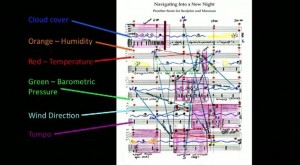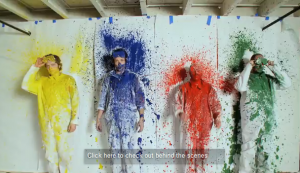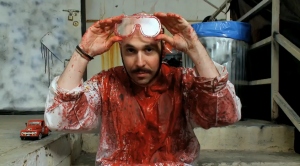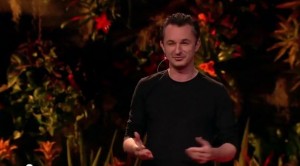Britta Riley: A Garden in my Apartment
Britta Riley is an artist, exhibition designer, and social entrepreneur
who works with social media to create mass participation in solving
environmental problems.
Her artwork has been featured at MoMA NY,
the Whitney, the Venice Biennial, Ars Electronica, on the Discovery
Channel’s Planet Green, Good Morning America,NPR and hundreds of
other press venues.
In this video of her presentation at TEDtalks, she makes a very interesting point in contrasting what is proving to be the new enlightened way of shared world-community living, with the outdated and often damaging “bully boy takes all” mentality that seemed to have seeped into the essence of giant multinational corporate thinking, which has apparently lost sight of humanity in its haste to try to monopolise all things, at any cost.
“I like many of you am one of the two billion people on earth who live in cities, and there are days when I palpably feel that I rely on other people for pretty much everything in my life and some days that can even be a little scary.
SOS: (Open) Source Of Solutions
But what I’m here to talk to you about today is how that same inter-dependence is actually an extremely powerful social infrastructure that we can harness to help heal some of our deepest civic issues, if we apply open source colaboration.
A couple of years ago, I read an article by New York Times writer Michael Collins in which he argued that growing even some of our own food is one of the best things that we can do for the environment.
Now at the time that I was reading this it was in the middle of the winter, and I definitely did not have room for a lot of dirt in my New York City apartment, so I was basically willing to settle for just reading the next wired magazine and finding out how the experts were going to figure out how to solve all these problems for us in the future. But that was actually exactly the point that Michael Collins was making in this article, that its precisely when we hand over the responsibility for all of these things over specialists that we cause the kind of messes that we see with the food system.
NASA’s Food for Starships
So, I happen to know a little from my own work about how NASA has been using hydroponics to explore growing food in space and that you can actually get optimal nutritional yields by running a kind of high quality liquid soil over plants root sytems.
Now, to a vegetable plant, my apartment has got to be about as foreign as outer space but I can offer some natural light and year-round climate control.
Fast forward two years later.
We now have window farms which are vertical hydroponic platforms for food growing indoors, and the way it works is that there’s a pump at the bottom which periodically sends some of this liquid nutrient solution up to the top, which then trickles down through the plant’s root systems, which are suspended in clay pellets, so there’s no dirt involved.
A Creative Alternative to Corporate Intellectual Property
Light and temperature vary with each window’s microclimate, so a window farm requires a farmer, and she must decide what kind of crops she is going to grow in her window farm, and whether she is going to feed her food organically.
Back at the time that the window farm was no more than a technically complex idea that was going to require a lot of testing and I really wanted to be an open project because hydroponics is one of the fastest growing areas of patenting in the United States now, and could possibly become like Monsanto where we have a lot of corporate intellectual property in the way of people’s food.

Artist Britta Riley's practical demonstration of the power of shared creativity in her open-source Window Farming project
So, I decided that instead of creating a product, I was going to open this up to a whole bunch of co-developers. The first few systems that we created kinda worked. We were actually able to grow about a salad a week in a typical New York City apartment window and we were able to grow cherry tomatoes and cucumbers, all kinds of stuff.
But the first few systems were these leaky, loud, power guzzlers that Martha Steward would definitely never have approved. So, to bring on more co-developers, what we did was we created a social media site on which we published the designs, we explained how they worked and we even went so far as to point out everything that was wrong with these systems. And then we invited people all over the world to build them and experiment with us. So actually now with us on this website we have 18,000 people and we have window farms all over the world.
R&D-I-Y
What we’re doing is what NASA or large corporations would call R&D or Research and Development, but what we call it is R&D-I-Y, or Research and Develop It Yourself. So, for example, Jackson came along and suggested that we use air pumps, instead of water pumps. It took building a whole bunch of systems to get it right, but once we did we were able to cut our carbon footprint nearly in half. Tony in Chicago has been taking on growing experiments like lots of other window farmers, and he’s been able to actually get his strawberries to fruit for nine months of the year in low-light conditions by simply changing out the organic nutrients.
And window farmers in Finland have been customising their window farms for the dark days of the Finnish winters by outfitting them with LED growlights that they are now making open-source and part of the project. So window farms have been evolving through a rapid versioning process similar to software and with every open-source project the real benefit is the interplay between people customising the systems for their own particular concerns, and the universal concern.
Free to Anyone, Anywhere
So my core team and I are able to concentrate on the improvements that actually benefit everyone, and we’re able to look out for the needs of newcomers, so for DIYers we provide free, very well tested instructions so that anyone anywhere around the world can build one of these systems for free, and there’s a patent pending on these systems as well that’s held by the community and to fund the project, we create products that we then sell to schools and to individuals who don’t have time to build their own systems.
Now within our community, a certain culture has appeared. In our culture it is better to be a tester who supports someone else’s idea than it is to be just the idea guy. What we get out of this project is we get support for our own work as well as an experience of actually contributing to the environmental movement in a way other than just screwing in new lightbulbs. But I think that Eileen expresses best what we really get out of this which is the actual joy of collaboration. She expresses here what it is actually like to see someone halfway across the world having taken your idea, built upon it and then acknowledging you for contributing.
We Need to “Do” More Than “Consume”
If we really want to see the wide consumer behaviour change that we’re all talking about as environmentalists and food people, maybe we just need to ditch the term “consumer” and get behind the people who are doing stuff.
Open source projects tend to have a momentum of their own what we’re seeing is that R&DIY has moved beyond just window farms and LEDs into solar panels and aquaponic systems 7:20 and we’re building apon innovations of generations who went before us, and we’re looking ahead at generations who really need us to re-tool our lives now.
So we ask that you join us in rediscovering the value of citizens united and to declare that we are all still pioneers.”
For more information on window farming, see http://www.windowfarms.org/
Britta Riley’s own website: http:// brittariley.carbonmade.com
Nathalie Miebach: Art made of storms
A unique artist who makes silent weather patterns tangible in her work, and even turns the results into musical scores.
Every artist has something unique to offer, but some art forms exceed the norms in an exceptional way. The work of Nathalie Miebach is anything but typical.
This instructor and maker of art holds two master’s degrees and has participated in dozens of solo and group exhibitions. Being a lover of art, science and music, Miebach found a way to take her vigorous passion and combine all three. In her latest series: “Sculptural Musical Scores” the result is baskets made of reed wood turned weather models with a musical twist.
Weather to be an Artist
Miebach makes use of a basket’s horizontal and vertical elements and carefully constructs 3-dimensional grids of weather data based on real-life weather patterns. Miebach has a long-time fascination with weather, and in her work the natural phenomenon we call storms are transformed into sculptures and musical compositions.
Miebach’s process always starts simple, with data collection using the Internet and supplies she accumulates at the hardware store. The result, however, is a mathematically complex mix of beads and colored bands. Although the tangled sculptures are complicated and sophisticated, every single detail represents something.
The Music of Nature
Components that may be indicated in Miebach’s sculptures include moon phases, air and water temperature, temperature ranges and tide levels. Each color, bead and band symbolizes a weather element that can also be read as a musical note. Using the weather data she collects, Miebach weaves together one of her intricate sculptures and then composes them into real musical scores.
“These pieces are not only devices that map meteorological conditions of a specific time and place, but are also functional musical scores to be played by musicians,” Miebach explains on her website.
“My work focuses on the intersection of art and science and the visual articulation of scientific observations. Using the methodologies and processes of both disciplines, I translate scientific data related to astronomy, ecology and meteorology woven sculptures. My method of translation is principally that of weaving – in particular basket weaving – as it provides me with a simple yet highly effective grid through which to interpret data in three-dimensional space.
By staying true to the numbers, these woven pieces tread an uneasy divide between functioning both as sculptures in space as well as instruments that could be used in the actual environment from which the data originates.”
Weaving Numbers into Sculptures
“My method of translation is principally that of weaving – in particular basket weaving – as it provides me with a simple yet highly effective grid through which to interpret data in three-dimensional space. By staying true to the numbers, these woven pieces tread an uneasy divide between functioning both as sculptures in space as well as instruments that could be used in the actual environment from which the data originates.
Central to this work is my desire to explore the role visual aesthetics play in the translation and understanding of science information. By utilizing artistic processes and everyday materials, I am questioning and expanding boundaries through which science data has been traditionally visually translated (ex: graphs, diagrams), while at the same time provoking expectations of what kind of visual vocabulary is considered to be in the domain of ‘science’ or ‘art’.”
The video is from the TEDtalksDirector YouTube channel, posted on the 21 Oct 2011.
For more information about this artist and to view samples of her work, visit nathaliemiebach.com.
Read MoreCreativity versus climate change
What if creativity and smart marketing could be combined to help inspire people to lead a greener life? James Alexander shows how it could be done.
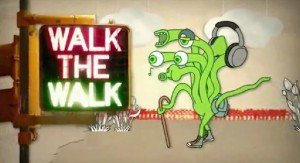 “I’m a naive Sagittarian optimist and I see a world of people helping one another to achieve their potential in a beautiful environment.
“I’m a naive Sagittarian optimist and I see a world of people helping one another to achieve their potential in a beautiful environment.
Others see a world to market to. And they are good at selling to it.
Take cars. They sell the seductive promise of a lifestyle. They sell on speed. They sell through oozing sexy sounds. They sell freedom. In short, they sell desire, and we cannot resist.
But in a resource constrained world, they are contributing to a problem of alarming magnitude.
Today, right now we are presiding over the first mass extinction of ants on this planet for 65 million years. And yet whilst almost all of us understand this, the truth is that in the developed world, very few of us have materially changed the way that we live.
And why might this be? In communcations terms, activists lobby, but their message does not appeal to many. Scientists, well they know the data, but their analysis and the prognosis tend to scare and paralyse rather than mobilise.
Politicians, business leaders and even celebrities often preach, and none of us like being told what to do. And as for us, we are all just too busy leading very complicated, complex lives and just juggling often competing priorities.
But perhaps great creativity can help us find a path through. Great creativity is astonishingly, absurdly, rationally, irrationally powerful.
Great creativity can spread tolerance, spread freedom, can shine a spotlight on social deprivation. Great creativity is the men maker that puts slogans on our t-shirts and phrases on our lips.
What if great creativity could be used to help inspire people to lead a more sustainable life? To turn it from a chore to a pleasure. To move it from being something we feel we ought to do to something that we want to do.
To make leading a greener life a little more cool, a little more desireable.
One such initiative that’s doing its bit to help on this is Green Thing, a community, a not-for profit created by Tedster Andy Hobsbawm and Pentagram partner Naresh Ramchandani Two wonderful people and creative marketeers that I’m lucky enough to work with.
Green thing aims to use creativity to inspire people to lead a greener life.
Remember the car? Here’s a little scrap of Creative Antidote: (shows video – “The Day Gusty Decided to Walk”)
Green Thing provides an Inspiration Feed: Stories, music, film, poetry and things both created and also curated, to help make people smile, think, want, act to make a difference.
Like these gloves I’m wearing. Lost single gloves, found around the world, sent in to Green Thing, lovingly mended and restored, and then marketed as something altogether more wonderful (glove love)
Or this t-shirt, found in the back of a cupboard, saved, and given a new lease of life.
Or this rather delicious light switch that we spied in Japan.
The science is done, the moral imperative is obvious. Creativity can play its part to make a difference. So this is a call, a plea to the wonderfully talented Ted Community – let’s get creative, and let’s do it soon.”
—————-
Comment on this on the forums
—————–
Presented to TEDtalks on 29 Oct 2011
Read MoreSomething for Halloween?

Once you’ve finished carving your Pumkin, get some more ideas for Halloween
with this Skull makeup art tutorial by Florida-based makeup artist eRaness,
including a rather novel idea for your cell phone.
eRaness is based in Miami Beach and works for Special Fx Makeup.
Have your say on this topic on the Forums…here
Read More
OK Go: This Too Shall Pass
This Too Shall Pass: Rube Goldberg Machine
“This Too Shall Pass: Rube Goldberg Machine” was the second video done for OK Go’s album “Of the Blue Colour of the Sky”. The single was released in January 2010 and the band made the unusual decision to create two official videos for the album, both of which premiered on YouTube.
The first video records a live performance of the song in collaboration with the University of Notre Dame Marching Band. For the second the band wanted “a giant machine that we dance with”.
It features a four-minute sequence of a song being played in time to the movements of a giant Rube Goldberg machine built over two storeys of a warehouse.
Rube Goldberg and Heath Robinson Dance in their Graves
Rube Goldberg is the American equivalent of Britain’s Heath Robinson. American inventor and cartoonist Rube Goldberg (1883-1970) was famous for his cartoons of intricately complicated over-engineered machines that manage to perform very simple tasks in hundreds of unnecessary mechanically inspired movements.
The sequence is carefully orchestrated but appears to be a single shot, following the convoluted route of objects along the machine. The contraption consists of more than 700 household objects which create a route estimated to be over half a mile long.
Parts of the machine are synchronised in time with the music, with members of the band singing alongside the machine and being shot at by paint guns in the grand finale.
This Too Shall Pass on YouTube
The video “This Too Shall Pass: Rube Goldberg Machine” appeared on YouTube on 2nd March 2010 and was viewed over 900,000 times on its first day, and reached 6 million views in six days…it has now been viewed over 30,876,540
times.
It was named both “Video of the Year” and “Best Rock Video” at the 3rd annual UK Music Video Awards
The Band: OK GO
The lead singer of the band Damien Kulashwas was attending the Interlichen Arts Camp to study graphic design and while there met, met the bassist Tim Nordwind who was there to study music. The name “OK GO” was inspired by their art teacher saying: “OK…Go! while they were drawing.
Kulash and Nordwindmet the band’s former guitarist and keyboardist Any Duncan in high school, and their drummer and percussionist Dan Konopka in college, and launched the band in 1998.
In 2005 Andy Ross – guitar, keyboards and vocals, joined them and replaced Andy Duncan.
Directed by James Frost, OK Go and Syyn Labs. Produced by Shirley Moyers. The official video for the recorded version of “This Too Shall Pass” off of the album “Of the Blue Colour of the Sky”. The video was filmed in a two-story warehouse, in the Echo Park neighborhood of Los Angeles, CA. The “machine” was designed and built by the band, along with members of Syyn Labs ( http://syynlabs.com/ ) over the course of several months.
You can share your views on this video or the band OK Go on our music forums:
To find out more about the making of the video, the an in-depth behind-the-scenes setup of the warehouse can be seen at:
http://www.okgo.net/this-too-shall-pass-rube-goldberg-machine/
OK Go on Tour http://www.okgo.net/shows/
Read MoreMarco Tempest: The magic of truth and lies (and iPods)
Marco Tempest began performing at a very young age and by the age of 22 had captured the prestigious New York World Cup of Magic. This launched him into the international spotlight.
He now has a full diary and a nomadic itinerary that sees him appearing throughout the year at shows and major events right across the world (including a TV series in China).
He calls himself a virtual magician and refers to his work as “Magic for both sides of your brain” and sees the magician as being “the one who makes dreams real first, before technology can get there…”
Marco embraces the latest technology recognising its potential in the creation of this magic. He uses his skill as a communicator and performer to combine high-tech computer-generated imagery, video, music and stagecraft to create his own memorable unique and magical moments for his audience.
Watch and enjoy.
Read More

